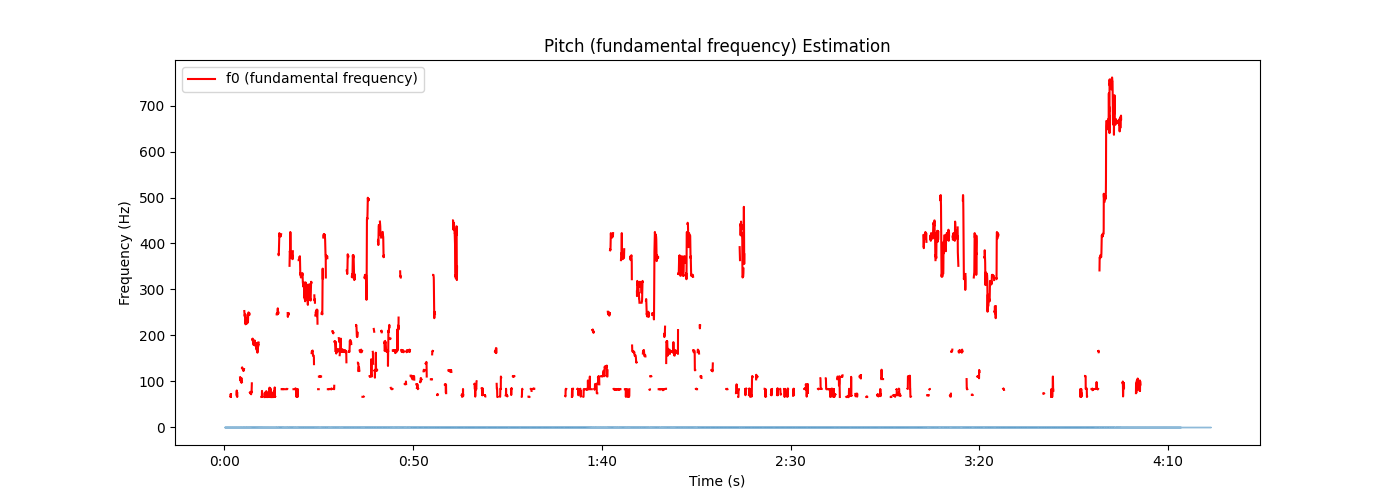python 音频处理(1)——重采样、音高提取
采集数据->采样率调整
使用
torchaudio进行重采样(cpu版)首先导入相关包,既然使用torch作为我们的选项,安装torch环境我就不必多说了,如果你不想用torch可以使用后文提到的另一个库
1 import torch
2 import torchaudio
3 from torchaudio.transforms import Resample
4 from time import time#仅计算时间,不影响主体使用
torchaudio.load导入音频文件设定目标采样率并构造
resample函数调用构造好的
resample函数调用
torchaudio的保存函数
封装一下,总函数【记得先导入】:
1 def resample_by_cpu():
2 file_path = input("please input your file path: ")
3 start_time = time()#不影响,可去掉
4 y, sr = torchaudio.load(file_path) #使用torchaudio.load导入音频文件
5
6 target_sample = 32000 #设定目标采样率
7 resampler = Resample(orig_freq=sr, new_freq=target_sample)#构造resample函数,输入原始采样率和目标采样率
8 resample_misic = resampler(y) #调用resample函数
9
10 torchaudio.save("test.mp3", resample_misic, target_sample)#调用torchaudio的保存即可
11 print(f"cost :{time() - start_time}s")#不影响,可去掉最后结果大概是几秒钟这样子
使用使用
torchaudio进行重采样(gpu版):有了上面cpu的基础,其实调用gpu也就更换一下设备,和放入gpu的操作就好了,因此不过多赘述
def resample_use_cuda():
device = torch.device('cuda' if torch.cuda.is_available() else 'cpu')
start_time = time()
file_path = input("please input your file path:")
y, sr = torchaudio.load(file_path)
y = y.to(device)
target_sample = 32000
resampler = Resample(orig_freq=sr, new_freq=target_sample).to(device)
resample_misic = resampler(y)
torchaudio.save("test.mp3", resample_misic.to('cpu'), target_sample) #这里注意要把结果从gpu中拿出来到cpu,不然会报错。
print(f"cost :{time() - start_time}s")时间方面嘛,单个音频多了放入gpu取出gpu的步骤肯定会稍慢的,但是跑过cuda都知道它的强大,更多是用于后续的操作说是。
使用librosa库进行重采样
具体步骤:
导入两个库文件,
librosa和音频文件读写库soundfileimport librosa
import soundfile as sf
from time import time#仅计算时间,不影响主体导入音频文件
设定目标采样率
重采样
输出
综合封装成函数:
1 def resample_by_lisa():
2 file_path = input("please input your file path:")
3 start_time = time()
4 y, sr = librosa.load(file_path) #使用librosa导入音频文件
5 target_sample_rate = 32000
6 y_32k = librosa.resample(y=y, orig_sr=sr, target_sr=target_sample_rate) #使用librosa进行重采样至目标采样率
7 sf.write("test_lisa.mp3", data=y_32k, samplerate=target_sample_rate) #使用soundfile进行文件写入
8 print(f"cost :{time() - start_time}s")总结:
优点,简单小巧,
ibrosa有很多能处理音频的功能缺点:无法调用cuda,保存的时候需要依赖
soundfile库。时间:也是几秒左右,和
torchaudiocpu版差不多小声bb:提取32k的效果好像没有torchaudio好【嘛,毕竟librosa历史有点久了,没有专注深度学习的torch好很正常啦】,你们也可以自己测一下
all code:
1 import torch
2 import torchaudio
3 from torchaudio.transforms import Resample
4 import librosa
5 import soundfile as sf
6 from time import time
7
8 def resample_by_cpu():
9 file_path = input("please input your file path: ")
10 start_time = time()
11 y, sr = torchaudio.load(file_path) #使用torchaudio.load导入音频文件
12
13 target_sample = 32000 #设定目标采样率
14 resampler = Resample(orig_freq=sr, new_freq=target_sample)#构造resample函数,输入原始采样率和目标采样率
15 resample_misic = resampler(y) #调用resample函数
16
17 torchaudio.save("test.mp3", resample_misic, target_sample)#调用torchaudio的保存即可
18 print(f"cost :{time() - start_time}s")
19 def resample_use_cuda():
20
21 device = torch.device('cuda' if torch.cuda.is_available() else 'cpu')
22 start_time = time()
23 file_path = input("please input your file path:")
24 y, sr = torchaudio.load(file_path)
25
26 y = y.to(device)
27 target_sample = 32000
28 resampler = Resample(orig_freq=sr, new_freq=target_sample).to(device)
29 resample_misic = resampler(y)
30 torchaudio.save("test.mp3", resample_misic.to('cpu'), target_sample)
31 print(f"cost :{time() - start_time}s")
32
33 def resample_by_lisa():
34 file_path = input("please input your file path:")
35 start_time = time()
36 y, sr = librosa.load(file_path)#使用librosa导入音频文件
37 target_sample_rate = 32000
38 y_32k = librosa.resample(y=y, orig_sr=sr, target_sr=target_sample_rate)#使用librosa进行重采样至目标采样率
39 sf.write("test_lisa.mp3", data=y_32k, samplerate=target_sample_rate)#使用soundfile进行文件写入
40 print(f"cost :{time() - start_time}s")
41
42 if __name__ == '__main__':
43 resample_use_cuda()
44 resample_by_cpu()
45 resample_by_lisa()
2.2 提取pitch基频特征【音高提取】
使用
torchaudio进行基频特征提取其实主要使用的这个函数:
torchaudio.transforms._transforms.PitchShift让我们来看看它官方的
example,仿照着来写就好啦>>> waveform, sample_rate = torchaudio.load("test.wav", normalize=True)
>>> transform = transforms.PitchShift(sample_rate, 4)
>>> waveform_shift = transform(waveform) # (channel, time)步骤:
导入依赖
import torchaudio
import torchaudio.transforms as Tf
import matplotlib.pyplot as plt #画图依赖
导入音频
构造
PitchShift使用这个函数对歌曲进行基频提取
code:
def get_pitch_by_torch():
file_path = input("file path:")
y, sr = torchaudio.load(file_path)
"""specimen:
>>> waveform, sample_rate = torchaudio.load("test.wav", normalize=True)
>>> transform = transforms.PitchShift(sample_rate, 4)
>>> waveform_shift = transform(waveform) # (channel, time)
"""
pitch_tf = Tf.PitchShift(sample_rate=sr, n_steps=0)
feature = pitch_tf(y)
# 绘制基频特征 这部分可以忽略,只是画图而已,可以直接复制不用理解
plt.figure(figsize=(16, 5))
plt.plot(feature[0].numpy(), label='Pitch')
plt.xlabel('Frame')
plt.ylabel('Frequency (Hz)')
plt.title('Pitch Estimation')
plt.legend()
plt.show()输出图片【总歌曲】效果:

将输出的范围稍微改一下,切分特征的一部分,就是歌曲部分的音高特征啦,效果就很明显了
改为:
plt.plot(feature[0][5000:10000].numpy(), label='Pitch')
使用librosa提取基频特征
步骤:
导入包
提取基频特征
(可选)绘制基频特征
主要函数:
librosa.pyin,请见官方example
#Computing a fundamental frequency (F0) curve from an audio input
>>> y, sr = librosa.load(librosa.ex('trumpet'))
>>> f0, voiced_flag, voiced_probs = librosa.pyin(y,
... sr=sr,
... fmin=librosa.note_to_hz('C2'),
... fmax=librosa.note_to_hz('C7'))
>>> times = librosa.times_like(f0, sr=sr)code:
1 def get_pitch_by_librosa():
2
3 file_path = input("请输入音频文件路径:")
4 y, sr = librosa.load(file_path)
5 """librosa.pyin(y,sr=sr,fmin=librosa.note_to_hz('C2'),fmax=librosa.note_to_hz('C7'))"""
6 # 使用pyin提取基频特征
7 f0, voiced_flag, voiced_probs = librosa.pyin(y, sr=sr, fmin=librosa.note_to_hz('C2'), fmax=librosa.note_to_hz('C7'))
8
9 # 绘制基频特征,可忽略
10 plt.figure(figsize=(14, 5))
11 librosa.display.waveshow(y, sr=sr, alpha=0.5)
12 plt.plot(librosa.times_like(f0), f0, label='f0 (fundamental frequency)', color='r')
13 plt.xlabel('Time (s)')
14 plt.ylabel('Frequency (Hz)')
15 plt.title('Pitch (fundamental frequency) Estimation')
16 plt.legend()
17 plt.show()总结:
比torchaudio略微麻烦一点,不过多了两个参数
voiced_flag, voiced_probs,看起来的视觉图好像也有些不一样,不过都是按照官方的这个来了,这也不对的话我也不会了
输出:

all code:
import torchaudio
import torchaudio.transforms as Tf
import matplotlib.pyplot as plt
import librosa
def get_pitch_by_torch():
file_path = input("file path:")
y, sr = torchaudio.load(file_path)
"""specimen:
>>> waveform, sample_rate = torchaudio.load("test.wav", normalize=True)
>>> transform = transforms.PitchShift(sample_rate, 4)
>>> waveform_shift = transform(waveform) # (channel, time)
"""
pitch_tf = Tf.PitchShift(sample_rate=sr, n_steps=0)
feature = pitch_tf(y)
# 绘制基频特征
plt.figure(figsize=(16, 5))
plt.plot(feature[0][5000:10000].numpy(), label='Pitch')
plt.xlabel('Frame')
plt.ylabel('Frequency (Hz)')
plt.title('Pitch Estimation')
plt.legend()
plt.show()
def get_pitch_by_librosa():
file_path = input("请输入音频文件路径:")
y, sr = librosa.load(file_path)
"""librosa.pyin(y,sr=sr,fmin=librosa.note_to_hz('C2'),fmax=librosa.note_to_hz('C7'))"""
# 使用pyin提取基频特征
f0, voiced_flag, voiced_probs = librosa.pyin(y, sr=sr, fmin=librosa.note_to_hz('C2'), fmax=librosa.note_to_hz('C7'))
# 绘制基频特征,可忽略
plt.figure(figsize=(14, 5))
librosa.display.waveshow(y, sr=sr, alpha=0.5)
plt.plot(librosa.times_like(f0), f0, label='f0 (fundamental frequency)', color='r')
plt.xlabel('Time (s)')
plt.ylabel('Frequency (Hz)')
plt.title('Pitch (fundamental frequency) Estimation')
plt.legend()
plt.show()
if __name__ == '__main__':
# get_pitch_by_torch()
# get_pitch_by_librosa()后续PPG特征、vec特征见下一章
python 音频处理(1)——重采样、音高提取的更多相关文章
- Python即时网络爬虫项目: 内容提取器的定义(Python2.7版本)
1. 项目背景 在Python即时网络爬虫项目启动说明中我们讨论一个数字:程序员浪费在调测内容提取规则上的时间太多了(见上图),从而我们发起了这个项目,把程序员从繁琐的调测规则中解放出来,投入到更高端 ...
- python操作三大主流数据库(5)python操作mysql⑤使用Jinja2模板提取优化页面展示
python操作mysql⑤使用Jinja2模板提取优化页面展示 在templates目录下的index.html.cat.html等页面有一些共同的元素,代码比较冗余可以使用模板提取公共代码,在各网 ...
- 『开发技巧』Python音频操作工具PyAudio上手教程
『开发技巧』Python音频操作工具PyAudio上手教程 0.引子 当需要使用Python处理音频数据时,使用python读取与播放声音必不可少,下面介绍一个好用的处理音频PyAudio工具包. ...
- < python音频库:Windows下pydub安装配置、过程出现的问题及常用API >
< python音频库:Windows下pydub安装配置.过程出现的问题及常用API > 背景 刚从B站上看过倒放挑战之后也想体验下,心血来潮一个晚上完成了基本的实现.其中倒放与播放部分 ...
- Python音频操作+同时播放两个音频
对于python而言,音频的操作可以使用pygame包中的sound 和 music对象,本博客主要讲解这两个对象. 1.sound对象 Sound对象适合处理较短的音乐,如OGG和WAV格式的音频文 ...
- python音频处理相关类库
一.eyeD3 以下是eyed3的官方介绍 eyeD3 is a Python tool for working with audio files, specifically mp3 files co ...
- Python即时网络爬虫项目: 内容提取器的定义
1. 项目背景 在python 即时网络爬虫项目启动说明中我们讨论一个数字:程序员浪费在调测内容提取规则上的时间,从而我们发起了这个项目,把程序员从繁琐的调测规则中解放出来,投入到更高端的数据处理工作 ...
- python音频处理用到的操作
作者:桂. 时间:2017-05-03 12:18:46 链接:http://www.cnblogs.com/xingshansi/p/6799994.html 前言 本文主要记录python下音频 ...
- 短文本分析----基于python的TF-IDF特征词标签自动化提取
绪论 最近做课题,需要分析短文本的标签,在短时间内学习了自然语言处理,社会标签推荐等非常时髦的技术.我们的需求非常类似于从大量短文本中获取关键词(融合社会标签和时间属性)进行用户画像.这一切的基础就是 ...
- Python爬虫10-页面解析数据提取思路方法与简单正则应用
GitHub代码练习地址:正则1:https://github.com/Neo-ML/PythonPractice/blob/master/SpiderPrac15_RE1.py 正则2:match. ...
随机推荐
- bpmnjs
在 bpmn.js 中,`bpmnModeler.get()` 方法用于获取不同的模块,你可以通过这些模块来访问和操作 BPMN 模型的不同部分.以下是一些常用的模块和对应的用途: 1. **Canv ...
- Node安装mongodb
Node操作mongodb Mongoose介绍 网址:http://www.mongoosejs.net/docs/index.html mongoose是Node环境下异步操作mongodb数据库 ...
- 支付宝支付jemter 插件,导入到高版本jmeter 中使用
官方支付宝压力测试文档中: 蚂蚁金服开放平台 - 文档中心 (alipay.com) 有个 temp.jmx 文件(http://p.tb.cn/rmsportal_10157_temp.jmx.zi ...
- OpenSSL生成加密证书.cer和.pfx
linux自带openssl,所以在linux平台操作. 先输入: openssl 再输入: genrsa -out private-rsa.key 1024 生成私钥,无密码保护的私钥. 输入: r ...
- k8s使用rbd作为存储
k8s使用rbd作为存储 如果需要使用rbd作为后端存储的话,需要先安装ceph-common 1. ceph集群创建rbd 需要提前在ceph集群上创建pool,然后创建image [root@ce ...
- Jmeter自动录制脚本
1.Jmeter配置 1.1新增一个线程组 1.2Jmeter中添加HTTP代理 1.3配置HTTP代理服务器 修改端口 修改Target Cintroller(目标控制器) 修改Grouping(分 ...
- K-means聚类是一种非常流行的聚类算法
K-means聚类是一种非常流行的聚类算法,它的目标是将n个样本划分到k个簇中,使得每个样本属于与其最近的均值(即簇中心)对应的簇,从而使得簇内的方差最小化.K-means聚类算法简单.易于实现,并且 ...
- 我所关注的几个spring设计模式
Spring框架中实现了许多的设计模式,而且都是非常优先的实现,这些值得我们学好好习. 不过话说回来,我觉得自己只要关注几个即可: 单例 工厂 代理 适配器 观察者 委派 在各种设计模式中,适配器和装 ...
- 配置h5py、netCDF4库的方法:Anaconda环境
本文介绍基于Anaconda环境,下载并安装Python中h5py与netCDF4这两个模块的方法. 在Python语言中,h5py与netCDF4这两个模块是与遥感图像处理.地学分析等GIS ...
- 码农的转型之路-全力以赴升级物联网浏览器(IoTBrowser)
在人生的重要时刻,我站在了毕业的门槛上,望着前方的道路,心中涌动着对未来的无限憧憬与些许忐忑.面前,两条道路蜿蜒伸展:一是继续在职场中寻求稳定,一是勇敢地走出一条属于自己的创新之路.尽管面临年龄和现实 ...
